 It is well-known that the Earth is subject to a changing climate. The last Ice Age ended about 20,000 years ago. More recently, the so-called Medieval Warm Period from about 900-1300 coincided with the Viking expansion to Iceland and Greenland. The Little Ice Age from 1500-1850 wreaked havoc with agricultural production worldwide and frequently froze European rivers and inland waterways. Since about 1850, however, the Earth has been in a warming period. In the past 30 years, this warming has accelerated to a point that exceeds normal climatic variations. That is why most scientists have now concluded that human activity is the best explanation for the current warming phase. The reason why the planet undergone anomalous warming is due to the greenhouse effect, an atmospheric situation created by the presence of higher levels of carbon dioxide resulting from the burning fossil fuels such as oil and gas. This excess CO2 traps heat in the atmosphere and causes the average temperature to increase. At current rates of increase of CO2 emissions, the Earth’s average temperature is likely to rise by 2-5 degrees celsius in the next two generations. Although this doesn’t sound like much (especially for those of us who live in cold northern climates), this may have a devastating effect on global ecosystems causing widespread flooding, increasing storm activity and crop failures.
It is well-known that the Earth is subject to a changing climate. The last Ice Age ended about 20,000 years ago. More recently, the so-called Medieval Warm Period from about 900-1300 coincided with the Viking expansion to Iceland and Greenland. The Little Ice Age from 1500-1850 wreaked havoc with agricultural production worldwide and frequently froze European rivers and inland waterways. Since about 1850, however, the Earth has been in a warming period. In the past 30 years, this warming has accelerated to a point that exceeds normal climatic variations. That is why most scientists have now concluded that human activity is the best explanation for the current warming phase. The reason why the planet undergone anomalous warming is due to the greenhouse effect, an atmospheric situation created by the presence of higher levels of carbon dioxide resulting from the burning fossil fuels such as oil and gas. This excess CO2 traps heat in the atmosphere and causes the average temperature to increase. At current rates of increase of CO2 emissions, the Earth’s average temperature is likely to rise by 2-5 degrees celsius in the next two generations. Although this doesn’t sound like much (especially for those of us who live in cold northern climates), this may have a devastating effect on global ecosystems causing widespread flooding, increasing storm activity and crop failures.
It is well-known that the Earth is subject to a changing climate. The last Ice Age ended about 20,000 years ago. More recently, the so-called Medieval Warm Period from about 900-1300 coincided with the Viking expansion to Iceland and Greenland. The Little Ice Age from 1500-1850 wreaked havoc with agricultural production worldwide and frequently froze European rivers and inland waterways. Since about 1850, however, the Earth has been in a warming period. In the past 30 years, this warming has accelerated to a point that exceeds normal climatic variations. That is why most scientists have now concluded that human activity is the best explanation for the current warming phase. The reason why the planet undergone anomalous warming is due to the greenhouse effect, an atmospheric situation created by the presence of higher levels of carbon dioxide resulting from the burning fossil fuels such as oil and gas. This excess CO2 traps heat in the atmosphere and causes the average temperature to increase. At current rates of increase of CO2 emissions, the Earth’s average temperature is likely to rise by 2-5 degrees celsius in the next two generations. Although this doesn’t sound like much (especially for those of us who live in cold northern climates), this may have a devastating effect on global ecosystems causing widespread flooding, increasing storm activity and crop failures.
Enter Astrology
"As above, so below", goes the astrologer’s maxim. While it is most unlikely that planetary motion causes anything to happen on Earth, astrology contends that there is a correspondence between the movement of the planets and life on Earth. This applies to both human and natural events. I believe it is possible to make sense of climate fluctuations by using planetary cycles. Just as astrometeorologists can predict weather patterns using annual ingress charts of the Sun, I believe the ingress of the outer slower-moving planets can give clues about longer-term trends such as climate change. For climatological periods that span hundreds of years, I hypothesize that the motion of the outer planets, especially Pluto, may offer an insight into climatological developments on Earth. Aside from its appropriately long 240-year periodicity, Pluto is the planet most associated with slow and deliberate change and transformation, characteristics that well demonstrate the shifting aspects of the weather. Another fitting parallel is that humans are subjected to the weather. We cannot change it; we must adapt to it. This is in keeping with the significations of Pluto as the planet that compels and forces changes upon us whether we want to to or not. Additionally, I will make the case for using Saturn Aries ingresses for assessing shorter climate cycles. Saturn is the slowest of the traditional seven planets and had many of the associations now conferred to Pluto: change that cannot be resisted, death, and the ultimate arbiter of Time. It may be true that all planetary ingresses have something to say about climate change. However, for purposes of brevity and efficacy, I have chosen to focus on Pluto and Saturn.
Simply stated, I assert that the ingresses of Saturn and Pluto into Aries reveals climatologically-relevant information. By reading the ingress chart and the influences on the ingressing planets and the Sun and Moon, we can establish if the coming period governed by the ingress will be predominantly warm, cold or neutral. With many influences and different ways of reading the chart, we need to be careful about the relative weight of the various factors. Although I am primarily a neo-Vedic astrologer, I will use only the tropical zodiac here. Although I believe the sidereal zodiac gives better results over time, I do not believe that the tropical zodiac is therefore "wrong". Rather it is another way of looking at the problem. Besides, the great 6th century Hindu astrologer Varahamihira advocated the use of tropical zodiac for evaluating solar ingresses for weather forecasting.
In terms of aspecting, I will generally follow standard Western aspecting with a special emphasis on hard aspects of the 8th harmonic — the conjunction, the semisquare, the square, the sesquisquare, and the opposition. Hard aspects convey planetary energy more directly to the recipient planet with less possibility of adaptation. So a square from Mars to the Sun will have a warmer effect than a trine from Mars to the Sun.
Planetary Characteristics
Each planet and constellation has a portfolio of characteristics including temperment, (Mars is aggressive), occupation (Venus is the artist), or parts of the body (Mercury rules the arms). Each planet and sign also govern different climatic conditions. Since they are the two fire planets, Mars and the Sun are the hottest influences in the horoscope. Saturn governs cold. The Moon, Mercury, Venus and Jupiter are somewhere in the middle, neither strongly warming or cooling. Jupiter is probably the warmest of this middle group, followed by the Moon and Venus which are both very mildly cooling. Mercury is the coolest of this middle group. The Moon’s nodes, Rahu and Ketu, are also potentially useful here. Rahu is usually given some of Mars’ qualities so it should be considered somewhat warm while Ketu is seen as Saturnine so it may be seen as cooling.
Since these observations are based on Vedic and Western traditional astrology, I will make cautious mention of the outer planets. However, we can infer that Uranus is likely a cooling planet due to its modern rulership of Saturn’s traditional sign Aquarius. Conversely, Pluto may be seen as warming given it’s rulership of Scorpio, a sign traditionally ruled by Mars. Neptune is primarily associated with liquids and moistured so we will aver that it is temperature-neutral in its effects.
We can summarize the temperature effects of the planets as approximate values.
| Mars | +5 | Warming |
| Sun | +4 | Warming |
| Pluto | +2 | Warming |
| Jupiter | +1 | Neutral/Warm |
| Venus | -1 | Neutral/Cool |
| Moon | -1 | Neutral/Cool |
| Neptune | -1 | Neutral/Cool |
| Uranus | -2 | Cooling |
| Mercury | -3 | Cooling |
| Saturn | -5 | Cooling |
A similar index of zodiac signs can be used whereby the fire signs Aries, Leo, and Sagittarius are all warming influences, while Capricorn, Aquarius and Gemini are cooling influences due to their association with Saturn and Mercury. The other six signs are more or less neutral in their temperature effects.
| Aries | +3 | Warming |
| Leo | +2 | Warming |
| Sagittarius | +1 | Warming |
| Scorpio | +1 | Warming |
| Pisces | 0 | Neutral |
| Taurus | 0 | Neutral |
| Cancer | 0 | Neutral |
| Libra | 0 | Neutral |
| Virgo | -1 | Cooling |
| Gemini | -1 | Cooling |
| Aquarius | -2 | Cooling |
| Capricorn | -3 | Cooling |
My aim here is understand the relative influence of these factors to achieve a clearer, more unequivocal way of interpreting the chart. A close hard aspect by Mars or the Sun to Pluto at the ingress will create more warming effects than if the Sun is in Leo on the day that Pluto enters Aries. Just to state my biases, planetary aspect effects are greater than zodiac sign placements. Close aspects occur less frequently than any particular sign placement and therefore they should receive more of our attention.
Interpreting the Charts
In terms of aspecting, I will generally follow standard Western aspecting with a special emphasis on hard aspects of the 8th harmonic — the conjunction, the semisquare, the square, the sesquisquare, and the opposition. Hard aspects convey planetary energy more directly to the recipient planet with less possibility of adaptation. My assumption is that all hard aspects confer the unmitigated essence of the aspecting planet that the receiving planet cannot filter or transform. For example, a Mars square to the Sun will be warmer than a Mars trine to the Sun. Similarly, a Saturn semisquare to the Moon will probbaly have a greater cooling effect than if the aspect was a trine.
Although I am primarily a neo-Vedic astrologer, I will use only the tropical zodiac here. Although I believe the sidereal zodiac gives better results over time, I do not believe that the tropical zodiac is therefore "wrong". Rather it is another way of looking at the problem. Moreover, the tropical zodiac with its emphasis on the seasons may have a special application for dealing with mundane matters such as meteorology. Indeed, no less than the great 6th century Hindu astrologer Varahamihira advocated the use of tropical zodiac for evaluating solar ingresses for weather forecasting. The leading Hindu astrologer of the 20th century, BV Raman, also supported Varahamihira in this support for the tropical ingress. This is strong advocation that allows my Vedic conscience to rest more easily!
Finally, I have chosen the last ingress into Aries in all cases instead of the first. In the case of slower-moving outer planets which may actually ingress three times into a sign, this is a significant question. After some observation of all ingresses, I have found the last ingress to be more reflective of the entire period covered by the ingress.
I use fairly standard orbs with closer orbs representing stronger influences. If there are no other aspects to a planet, then we should be prepared to accept the significance of a wider-orbed planet. The full temperature value of a planet is conveyed if in a tight aspect, say less than 2 degrees. This influence is correspondingly reduced as the orb increases.
It would be possible to bring in all sorts of factors but to keep things simple I have chosen to stick to the basics in terms of planets, aspects, and orbs.
In assigning a numerical temperature index to each chart influence, I hope to gain a better understanding of the likely climatological correspondence of each chart.
The Climate Change Record: Identifying Key Data Points
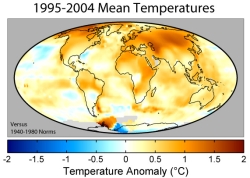 In attempting to illuminate climate trends using astrology,I will make use historical climatological data. There is a dizzying amount of scientific research being conducted by climate scientists much of which is contradictory and highly technical. However, there are several main themes that emerge from this research. The climate is always changing and is subject to a number of key inputs that affect climate outcomes. These include 1) changes in the Sun’s luminosity, 2) slight perturbations in the Earth’s orbit; 3) changes in volcanic activity; 4) changes in ocean currents, and 5) changes in the atmosphere.
In attempting to illuminate climate trends using astrology,I will make use historical climatological data. There is a dizzying amount of scientific research being conducted by climate scientists much of which is contradictory and highly technical. However, there are several main themes that emerge from this research. The climate is always changing and is subject to a number of key inputs that affect climate outcomes. These include 1) changes in the Sun’s luminosity, 2) slight perturbations in the Earth’s orbit; 3) changes in volcanic activity; 4) changes in ocean currents, and 5) changes in the atmosphere.
If astrology has something to say about the future of the Earth’s climate, then it has to be shown to be concisely reflecting past trends. While the Earth has undergone numerous glacial periods in the past 100,000 years, this clear climatic variations are beyond the scope of this study. It would be fascinating to see which astronomical cycles might correspond with these previous Ice Ages. No doubt, the cycles would have to be very long, at least 10,000 or 20,000 years. Perhaps the precession of the equinoxes is involved in tandem with certain fixed stars. For shorter cycles such as Pluto’s 243 year orbit, we will have to limit our analysis to the more recent past. First the so-called Medieval Warm Period is said to have lasted from about 900 to 1300 A.D. While this period was perhaps warmer than current conditions in some regions, most notably in the countries of the North Atlantic, it it less certain how uniformly warm it was in other locales. China and Japan show some warmth but it occurred earlier and it had cooled by 1200. So while the Medieval Warm Period can be our first data point to test, we should perhaps expect more equivocal results with only slight to moderate warming overall.
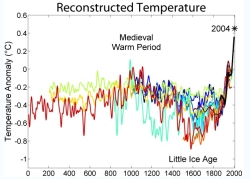 The next climate period to assess is the Little Ice Age that occurred from roughly 1500-1850. This appears to have been a stronger trend that is better documented. Temperatures were at least 1C cooler than our climate today. The relevant Pluto ingress for this period should therefore show a clear cooling influence.
The next climate period to assess is the Little Ice Age that occurred from roughly 1500-1850. This appears to have been a stronger trend that is better documented. Temperatures were at least 1C cooler than our climate today. The relevant Pluto ingress for this period should therefore show a clear cooling influence.
The Little Ice Age ended in the middle of the 19th century as temperatures gradually warmed across the world. This warming trend was not even, however. We can therefore put our shorter Saturn cycles to the test and see how well they predict the climatic variations in our time. There was a distinct warming trend from about 1900-1940 where global temperatures rose 0.4C. This was followed by a cooling of 0.2C between 1940-1970. Since 1970, we have been in a sharp upswing as temperatures have risen 0.6C. We will see how well Saturn’s ingress cycle corresponds to these variations.
Planetary Cycles and Climate Change
To begin, let’s look at the first key Pluto ingress that corresponds with the early part of the so-called Medieval Warm Period which is usually dated from 900-1300. This occurred January 18, 846 A.D. at 2.00 am in London, England. I have somewhat arbitrarily used London as my location for these charts. Since we want to examine global trends in climate, I will not be analyzing angles or planetary house positions and will instead stick to basic planetary aspects and sign placements. And even if I wanted a more regional analysis, it wouldn’t be possible owing to the 4-hour margin of error in the orbit of Pluto. While this period from 846 to the next ingress of 1090 A.D. was probably warmer than the long-term trend line, it is unclear just how warm it was.
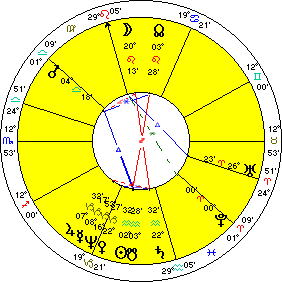 Pluto Aries Ingress Jan 18, 846 A.D.Our first task is to assess influences on the ingress point itself. Strong influences here are arguably the most significant for temperature trends during the ingress period. We find the only significant aspect is the opposition from Mars with a four degree orb. This is clearly a warming influence since Mars is a warm planet and the opposition aspect conveys the Mars energy to Pluto directly. Given the orb, I would evaulate this influence as a +3, assuming an Mars aspect of less than one degree orb would be a +5. Now we can look at the condition of the Sun and Moon, which are secondary influences on the chart. The Sun is in cool Aquarius with the South Node. It is also in a wide 20 degree conjunction with cold Saturn. While this probably exerts some cooling effect, I would assess this as -1. The Moon is in warming Leo and is in a semisquare aspect with Mars. I give this a +2. Overall the temperature index of this chart is +4. Clearly this ingress signals a warming period on the Earth.
Pluto Aries Ingress Jan 18, 846 A.D.Our first task is to assess influences on the ingress point itself. Strong influences here are arguably the most significant for temperature trends during the ingress period. We find the only significant aspect is the opposition from Mars with a four degree orb. This is clearly a warming influence since Mars is a warm planet and the opposition aspect conveys the Mars energy to Pluto directly. Given the orb, I would evaulate this influence as a +3, assuming an Mars aspect of less than one degree orb would be a +5. Now we can look at the condition of the Sun and Moon, which are secondary influences on the chart. The Sun is in cool Aquarius with the South Node. It is also in a wide 20 degree conjunction with cold Saturn. While this probably exerts some cooling effect, I would assess this as -1. The Moon is in warming Leo and is in a semisquare aspect with Mars. I give this a +2. Overall the temperature index of this chart is +4. Clearly this ingress signals a warming period on the Earth.
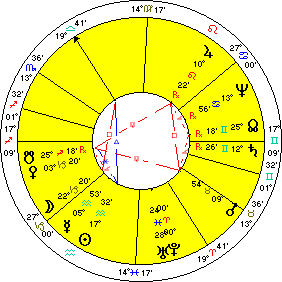 Pluto Aries Ingress Jan 31 1090 A.D.In discussing the next Pluto ingress, we need to be aware of the ambiguous climatological record. Although the data is sparse, it seems that the early part of the period in Europe was still warmer than normal. This started to change around 1300 when the weather turned cooler and mor unpredictable. In East Asia, however, records show that the previous warm period has turned much earlier, perhaps as early as 1100. The next Pluto ingress occurring on January 31, 1090 A.D. at approximately 4.09 am. covers the period up until 1331 A.D. Given the mixed nature of the records, we might expect more of a mixed picture in terms of the chart although a warm bias may still be detectable.
Pluto Aries Ingress Jan 31 1090 A.D.In discussing the next Pluto ingress, we need to be aware of the ambiguous climatological record. Although the data is sparse, it seems that the early part of the period in Europe was still warmer than normal. This started to change around 1300 when the weather turned cooler and mor unpredictable. In East Asia, however, records show that the previous warm period has turned much earlier, perhaps as early as 1100. The next Pluto ingress occurring on January 31, 1090 A.D. at approximately 4.09 am. covers the period up until 1331 A.D. Given the mixed nature of the records, we might expect more of a mixed picture in terms of the chart although a warm bias may still be detectable.
We first notice the proximity of Uranus to Pluto at the time of the ingress. This is a distinct cooling effect. Given the close orb, this is a -2. Both the Sun and Moon are in Saturn-ruled signs, so I give those each -1. There are no clear signs of heating in this chart. Overall, this is a cooling chart with a score of -4.
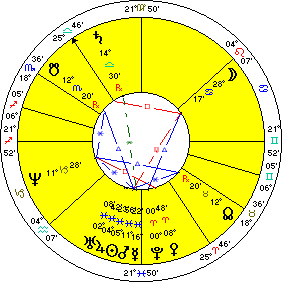 Pluto Aries Ingress Feb 16 1334 A.D.The next ingress covers a period that is widely believed to be a gradual cooling leading into the Little Ice Age that began around 1500. So while temperatures were not sharply lower they were likely trending lower. We would therefore expect a negative heat index. Pluto moved into Aries on February 16 1334 at 3.21 am. Venus is widely conjunct Pluto in Aries (a mild cooling effect), while Sun conjoined four other planets in Pisces. Although the Mars effect on the Sun is warming, the Uranus conjunction largely offsets it, especially since it is closer in orb. The Moon in Cancer is temperature-neutral. In sum, this chart is can be seen as a 0, a chart without clear heat bias. While we would have liked to have seen more cooling, it at least is not a strongly warming chart which would be at odds with the cooling historical evidence.
Pluto Aries Ingress Feb 16 1334 A.D.The next ingress covers a period that is widely believed to be a gradual cooling leading into the Little Ice Age that began around 1500. So while temperatures were not sharply lower they were likely trending lower. We would therefore expect a negative heat index. Pluto moved into Aries on February 16 1334 at 3.21 am. Venus is widely conjunct Pluto in Aries (a mild cooling effect), while Sun conjoined four other planets in Pisces. Although the Mars effect on the Sun is warming, the Uranus conjunction largely offsets it, especially since it is closer in orb. The Moon in Cancer is temperature-neutral. In sum, this chart is can be seen as a 0, a chart without clear heat bias. While we would have liked to have seen more cooling, it at least is not a strongly warming chart which would be at odds with the cooling historical evidence.
The next ingress chart (January 20, 1579 11.44 pm) coincides nicely with the Little Ice Age. This was an extended period of below normal temperatures that lasted well into the 19th-century. Although average temperatures averaged only 1C below normal, this was enough to reduce growing seasons by several weeks in many locales, cause countless crop failures and subsequent famines, and limit population growth. Glaciers advanced in the Alps swallowing entire villages in some cases, while the Thames River routinely froze. It has also been suggested that Breughel’s famous paintings of winter scenes dating from the 16th century could only have been possible with a colder European climate.
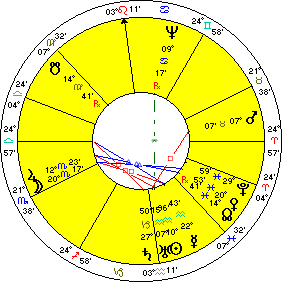 Pluto Aries Ingress Jan 20 1579 A.D.This ingress chart has Venus in a wide 10-degree conjunction with Pluto, a very mild cooling influence. Saturn casts a sextile to Pluto, another cooling influence. Given the 2+ degree orb, we don’t want to assign in too weight, but it is nonetheless significant. As a practicing neo-Vedic astrologer, I would also think that this so-called "soft" Saturn aspect may pack a heavier punch since according to Vedic aspect rules, it is a full-strength aspect. Moreover, Saturn is in its own cold sign of Capricorn. Together, I would assess these influences as -2.
Pluto Aries Ingress Jan 20 1579 A.D.This ingress chart has Venus in a wide 10-degree conjunction with Pluto, a very mild cooling influence. Saturn casts a sextile to Pluto, another cooling influence. Given the 2+ degree orb, we don’t want to assign in too weight, but it is nonetheless significant. As a practicing neo-Vedic astrologer, I would also think that this so-called "soft" Saturn aspect may pack a heavier punch since according to Vedic aspect rules, it is a full-strength aspect. Moreover, Saturn is in its own cold sign of Capricorn. Together, I would assess these influences as -2.
Sun is in cold Aquarius closely conjunct cold Uranus. However, it also receives a square aspect from hot Mars. Overall, these influences mostly cancel each other out, although the Sun’s presence in a Saturn-owned sign (and recall that dispositor Saturn is cold in Capricorn) tips the balance slightly towards a net cooling effect of -1. The Moon is in warm Scorpio but is closely squared by cool, windy Mercury. I would think this would have a net cooling effect on the Moon and give it a -1 score. Altogether, this chart has a temperature index of -4 and largely confirms the climatological record of a colder than normal period.
The most recent Pluto ingress to tropical Aries occurred on March 3, 1823 at 11.02 am. Since Pluto takes about 240 years to orbit the Sun, this is the ingress we are currently living under and will be "in effect" until 2068. The Little Ice Age gave way to a warming period soon after this ingress and temperatures have increased almost 1C since 1850. So even including the past 150 years into our analysis, we should expect to see some significant warming influences on the planetary relationships of this chart.
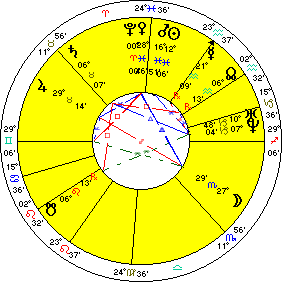 Pluto Aries Ingress March 3, 1823Venus closely conjoins Pluto for a slight cooling influence of -1. But the Sun conjoins Mars (albeit in Pisces) and this coming together of the two fiery planets is a +3. So far, this has a net heat effect of +2. The Moon is once again in warm Scorpio and is tightly opposed by the gently warming Jupiter. Jupiter’s heating influence may in fact be slightly enhanced by virtue of its dispositor Venus being in such close conjunction with warm Pluto. This counts as a +2. All told, this most recent ingress comes in at a warm +4.
Pluto Aries Ingress March 3, 1823Venus closely conjoins Pluto for a slight cooling influence of -1. But the Sun conjoins Mars (albeit in Pisces) and this coming together of the two fiery planets is a +3. So far, this has a net heat effect of +2. The Moon is once again in warm Scorpio and is tightly opposed by the gently warming Jupiter. Jupiter’s heating influence may in fact be slightly enhanced by virtue of its dispositor Venus being in such close conjunction with warm Pluto. This counts as a +2. All told, this most recent ingress comes in at a warm +4.
While this broadly supports recent prevailing temperature trends, it is not that helpful forecasting future trends. While the chart was warm, this may have only accounted for the warmth of the past 150 years. Since the heat index wasn’t "off the charts", we may consider the possiblity that global warming will not pose a huge threat to humanity. At this point, I think it would be useful to examine some other ingress charts to break down the long-term cycles into smalle, more manageable ones. So next we can turn to 29-year Saturn ingress charts.
Before using these charts for future forecasts, we need to establish their accuracy in correlating with past climate fluctuations. It is well known, for example, that the warming of the 20th century did not occur evenly. The period from about 1900-1940 saw an average temperature increase of about 0.4C, which was then followed by a drop of 0.2C from 1940-1970. Since 1970, the Earth has warmed by another 0.6C. Fortunately, these phases of climate history roughly correspond to separate Saturn cycles. Saturn ingressed into Aries in 1908 which fit the initial warm period, and then in 1938 which matched the cool period, then in 1967 which approximated the most recent warm phase. Saturn entered Aries most recently in 1996.
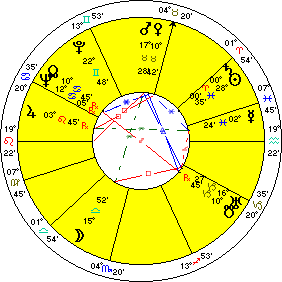 Saturn Aries Ingress March 19, 1908As we saw in most of the Pluto ingresses, the planetary influences in the Saturn ingress charts are closely mirror the temperature patterns on Earth. The heating influences in the 1908 ingress chart (March 19, 1908 2.22 pm) are clear just as we would predict from the climate record. The fiery Sun is less than two degrees from Saturn — a very warm influence that I would say is a +3. Another source of warmth comes from the semisquare with hot Mars. Since the orb is slightly over 2 degrees which is quite a bit for a lesser aspect, we should give this influence a modest +2. The Moon is in neutral Libra and unaspected. Sun of course is conjunct cold Saturn. So we have a bit of a conundrum. Is the Sun’s warmth cooled by its proximity to Saturn or is Saturn warmed to a greater degree by the Sun? Although the Sun is cooled by Saturn to some extent, it is the ingress point that is our primary focus and influences on it prevail over other influences in the chart. For that reason, I would say the net effect of the Sun-Saturn conjunction is a warming one, say +2, for the duration of the that Saturn cycle. Altogether, the influences in this chart add up to +4, a pronouced warming effect. This is in keeping with the sharp rise experienced between 1900 and 1940.
Saturn Aries Ingress March 19, 1908As we saw in most of the Pluto ingresses, the planetary influences in the Saturn ingress charts are closely mirror the temperature patterns on Earth. The heating influences in the 1908 ingress chart (March 19, 1908 2.22 pm) are clear just as we would predict from the climate record. The fiery Sun is less than two degrees from Saturn — a very warm influence that I would say is a +3. Another source of warmth comes from the semisquare with hot Mars. Since the orb is slightly over 2 degrees which is quite a bit for a lesser aspect, we should give this influence a modest +2. The Moon is in neutral Libra and unaspected. Sun of course is conjunct cold Saturn. So we have a bit of a conundrum. Is the Sun’s warmth cooled by its proximity to Saturn or is Saturn warmed to a greater degree by the Sun? Although the Sun is cooled by Saturn to some extent, it is the ingress point that is our primary focus and influences on it prevail over other influences in the chart. For that reason, I would say the net effect of the Sun-Saturn conjunction is a warming one, say +2, for the duration of the that Saturn cycle. Altogether, the influences in this chart add up to +4, a pronouced warming effect. This is in keeping with the sharp rise experienced between 1900 and 1940.
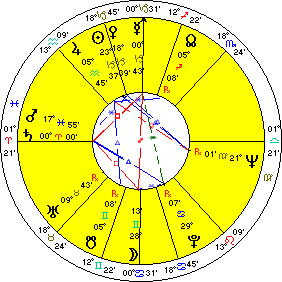 Saturn Aries Ingress January 14, 1938The next Saturn ingress took place on January 14, 1938 10.30 am and corresponded with a cooling period where the average temperature fell by 0.2C. Here Mars is in a wide 13-degree conjunction with Saturn. This is too wide for my liking, but since it is an applying conunction, it’s best not to ignore it completely (+1.) The closest aspects to Saturn come from Mercury (-3) and the Moon (-1) and form a close t-square. Significantly both of these planets are cooling, and the Moon is placed in chilly Gemini (-1) while Mercury is in cold Capricorn. Together, this t-square counts for -5. The Sun is in cold Capricorn with Venus, for a cooling effect of -1. Pluto makes a close trine with Saturn so that might be another minor source of heating in this chart (-1). Overall, this chart weighs in at -4, a cooling chart indeed. This fits nicely with the climatological record.
Saturn Aries Ingress January 14, 1938The next Saturn ingress took place on January 14, 1938 10.30 am and corresponded with a cooling period where the average temperature fell by 0.2C. Here Mars is in a wide 13-degree conjunction with Saturn. This is too wide for my liking, but since it is an applying conunction, it’s best not to ignore it completely (+1.) The closest aspects to Saturn come from Mercury (-3) and the Moon (-1) and form a close t-square. Significantly both of these planets are cooling, and the Moon is placed in chilly Gemini (-1) while Mercury is in cold Capricorn. Together, this t-square counts for -5. The Sun is in cold Capricorn with Venus, for a cooling effect of -1. Pluto makes a close trine with Saturn so that might be another minor source of heating in this chart (-1). Overall, this chart weighs in at -4, a cooling chart indeed. This fits nicely with the climatological record.
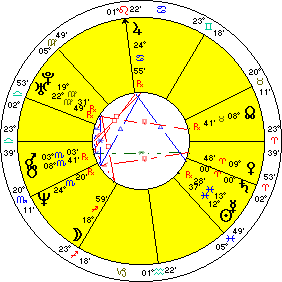 Saturn Aries Ingress March 3, 1967The next Saturn ingress occurred on March 3, 1967 9.31 pm and approximately marked the beginning of a heating phase in our climate. Venus conjoins Saturn in Aries but it’s a wide aspect so that’s really a wash. The Sun in Pisces is closely conjoined by a retrograde Mercury so that’s a cooling influence of -2. Mars makes a quincunx aspect with Saturn with a 3 degree orb. Although quinucunxes are not considered hard aspects, they are usually seen as difficult in some way and the respective energies of the planets are not well integrated. In other words, Mars’ heat is delivered without adaptation to Saturn. Moerover, since Mars is in warm Scorpio, I would consider this a significantly heating influence (+3). The Moon is the fire sign of Sagittarius (+1), most closely aspected (by a square) by warm Pluto (+1). Cold Uranus is also making a square aspect but it has a wider orb and is therefore trumped by Pluto. The overall heat index in this chart is +3. Again this confirms the climatological record of significant warming during the bulk of the period of this Saturn cycle from 1967-1996.
Saturn Aries Ingress March 3, 1967The next Saturn ingress occurred on March 3, 1967 9.31 pm and approximately marked the beginning of a heating phase in our climate. Venus conjoins Saturn in Aries but it’s a wide aspect so that’s really a wash. The Sun in Pisces is closely conjoined by a retrograde Mercury so that’s a cooling influence of -2. Mars makes a quincunx aspect with Saturn with a 3 degree orb. Although quinucunxes are not considered hard aspects, they are usually seen as difficult in some way and the respective energies of the planets are not well integrated. In other words, Mars’ heat is delivered without adaptation to Saturn. Moerover, since Mars is in warm Scorpio, I would consider this a significantly heating influence (+3). The Moon is the fire sign of Sagittarius (+1), most closely aspected (by a square) by warm Pluto (+1). Cold Uranus is also making a square aspect but it has a wider orb and is therefore trumped by Pluto. The overall heat index in this chart is +3. Again this confirms the climatological record of significant warming during the bulk of the period of this Saturn cycle from 1967-1996.
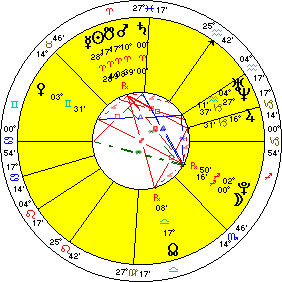 Saturn Aries Ingress April 7, 1996The last time Saturn entered tropical Aries happened on April 7 1996 at 8.49 am. This ingress would therefore reflect temperature trends up to about 2026. Although we have only lived through about one third of this cycle, we would expect the chart to have a biase towards warmth, given the past 10 years and the predictions of the climate scientists. And what do we find? No less than Sun, Mercury, Mars and the South Node all in Aries, the hottest sign in the zodiac! Although the conjunction of Mars to Saturn is a bit wide (10 degrees), the fact that it is in Aries makes it warmer (+2). The Sun is in Aries (+2), widely conjunct Mercury (-1) and Mars (+2). The Sun is also squared by gently warming Jupiter (+1). The Moon is in warm Sagittarius, closely conjoining warm Pluto (+2). Altogether, this is a very warm chart (+8). Although Saturn cycles are only one out of many possible relevant cycles, the extent of heat shown in this ingress chart strongly suggests that the rapid rate of warming will continue, irrespective of whatever legislative action can be taken to curb CO2 emissions.
Saturn Aries Ingress April 7, 1996The last time Saturn entered tropical Aries happened on April 7 1996 at 8.49 am. This ingress would therefore reflect temperature trends up to about 2026. Although we have only lived through about one third of this cycle, we would expect the chart to have a biase towards warmth, given the past 10 years and the predictions of the climate scientists. And what do we find? No less than Sun, Mercury, Mars and the South Node all in Aries, the hottest sign in the zodiac! Although the conjunction of Mars to Saturn is a bit wide (10 degrees), the fact that it is in Aries makes it warmer (+2). The Sun is in Aries (+2), widely conjunct Mercury (-1) and Mars (+2). The Sun is also squared by gently warming Jupiter (+1). The Moon is in warm Sagittarius, closely conjoining warm Pluto (+2). Altogether, this is a very warm chart (+8). Although Saturn cycles are only one out of many possible relevant cycles, the extent of heat shown in this ingress chart strongly suggests that the rapid rate of warming will continue, irrespective of whatever legislative action can be taken to curb CO2 emissions.
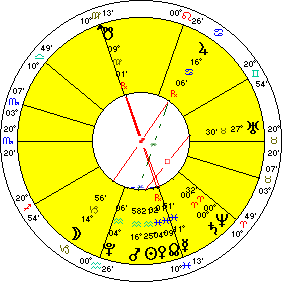 Saturn Ingress February 14, 2026And what does the future hold? The next Saturn ingress (February 14 2026 00.11 am) presents a perplexing picture. Cool, wet Neptune closely conjoins Saturn (-1). Sun in cold Aquarius widely conjoined with Mars and Venus, which can be considered offsetting influences. However, Mars is semisquare Saturn within two degrees, so that is the source of some heating (+2). Moon is in cold Capricorn (-1). Overall, this chart is essentially temperature neutral. The absence of any clear heating influences may indicate that our efforts to reduce greenhouse gas emissions will have paid off or the Earth may experience a temporary levelling off of global warming before more warming occurs at a later date.
Saturn Ingress February 14, 2026And what does the future hold? The next Saturn ingress (February 14 2026 00.11 am) presents a perplexing picture. Cool, wet Neptune closely conjoins Saturn (-1). Sun in cold Aquarius widely conjoined with Mars and Venus, which can be considered offsetting influences. However, Mars is semisquare Saturn within two degrees, so that is the source of some heating (+2). Moon is in cold Capricorn (-1). Overall, this chart is essentially temperature neutral. The absence of any clear heating influences may indicate that our efforts to reduce greenhouse gas emissions will have paid off or the Earth may experience a temporary levelling off of global warming before more warming occurs at a later date.
Another way of reading it, however, is that the Neptune conjunction represents flooding as a result of the rising temperatures of the previous decades. Given current accelerating rates of melting of the major ice caps in the Arctic Ocean, Greenland, and Antartica, this is a real possibility. This doesn’t mean that flooding will be catastrophic, only significant. Let us hope that the flooding occurs slowly enough that most regions are able to prepare for it with minimal disruption and hardship.


